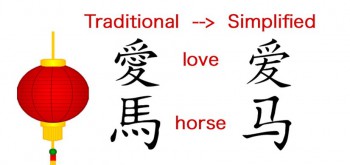It’s fairly common knowledge that there are two main branches of Chinese — Mandarin and Cantonese. The dialects share the same alphabet, but are fairly distinct when spoken. Mandarin is China’s official State language, and the primary dialect in both Beijing and Shanghai. Most residents of Taiwan and Singapore speak Mandarin as well.
Cantonese, on the other hand, is the predominant language spoken by the people of Hong Kong, Macau and the Guangdong province, including Guangzhou (previously Canton in English). Most expatriate Chinese communities, like those in Northern California, also speak Cantonese thanks to emigration from those sections of the country.
What is less known in the West is the split within Mandarin Chinese. In the middle of the 20th Century, the government of Mainland China “simplified” the written forms of many “traditional” words to make learning to read and write easier for the population that was largely illiterate at the time.
The Simplified Chinese writing system differs in two ways from the Traditional system. The first is a reduction in the number of strokes per character (see examples below). The second big change was the reduction of the number of characters in common use (two different characters are now written with the same character). In other words the simplification of Mandarin Chinese was a modification in how the language is written, not necessarily in how it is spoken.

Purists and linguists find the new characters much less pleasant to look at, but the simplification was largely successful in boosting literacy rates across China. All languages evolve over time; in the case of Mandarin Chinese, the process just received a major injection of modernization and standardization from the government, instead of waiting for Father Time to run his course. Of course the simplification of Mandarin has also been a boon to non-native speakers looking to learn Chinese, though this doesn’t mean that every person looking to develop Chinese-language should focus only on simplified Mandarin.
TutorABC Chinese is proud to offer both version of instruction; our teachers are trained to help students learn Simplified and Traditional Chinese. The decision is yours. If you’re wondering which you should learn consider this: Simplified Chinese should do the trick. That’s the dominant language now for the younger generation and for business types. You can choose to learn Traditional Mandarin for intellectual or family reasons but for most people looking to add the Chinese language to their skill sets, simplified should be more than suitable.
The exception is for those who will be conducting their business in Hong Kong or Taiwan; those regions have held on to the Traditional language and do not use the Simplified words much at all.
Founded in 2004, TutorABC Global, the parent company of TutorABC Chinese, created the first commercially available synchronous learning portal in the world. TutorABC Global offers world class Chinese tutors at TutorABC Chinese. For English learning, it offers TutorABC, and tutorJr.
Like this post? Join uS to learn more!
